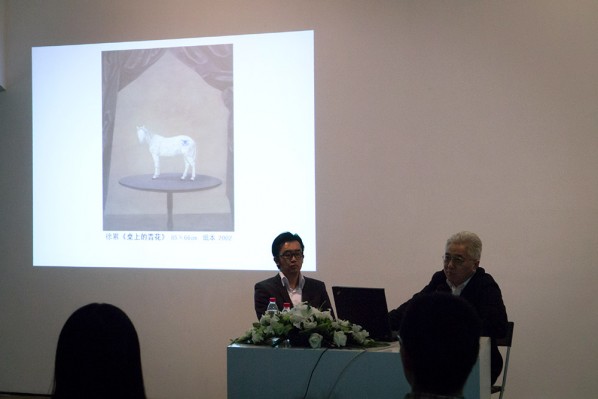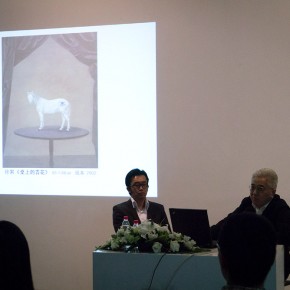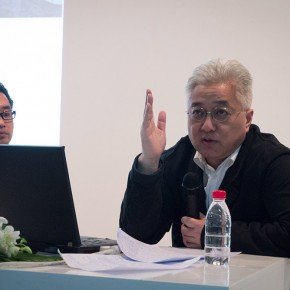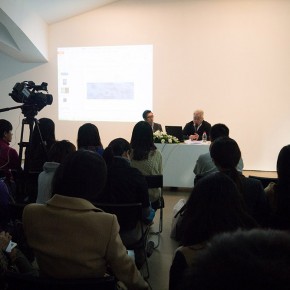
"Boundary in the Arts" lecture by Xu Lei was held on the second floor of exhibition hall 2 in Today Art Museum at 15:00 on October 26th. The host initially made a detailed introduction of the artist. Xu Lei was born in Nantong, Jiangsu Province in 1963, and graduated from the Department of Fine Arts, Nanjing University of the Arts, majored in Chinese painting, and used to be a professional painter and researcher in the Jiangsu Institute of Chinese Painting. Currently he lives in Beijing and works at the Creation and Research Center Affiliated to the China National Academy of Arts, first-class artist that serves as the art director of the Today Art Museum, and is the editor-in-chief of the magazine Classics.
Xu Lei expounded his view on art around the different stages of his works, combining the images and language to clearly express his creative thoughts as well as views on the history of art. He initially introduced the works presented in the “Veneer of the World” which was recently held at the Today Art Museum. In the works “Gossamer”, he depicted the scene of circus animals and a tightrope. The cable on the screen meant the balance, with the bird and elephant in three-dimensional work and two-dimensional stones, etc., explored an equal relationship between the two ends. The screen was expanded in the form of a Chinese scroll painting, equally divided according to the sequence of time. In the works entitled “The Moral Integrity”, the screens were divided into two parallel parts, performance of the unity of the reality and illusion located at two ends, Xu Lei said it contained a hope that different painting genres could find commonality in diversity, for mutual integration. The concept of equal and bisection appeared very early in his creation, in the works “Day and Night” created in 1990, Xu applied axis to bisect the day and night, as well as a table and apples, the symmetry composition is extremely common in his paintings, and is reflected in the creations in different periods. Equally expressing opposite ends as a composition approach that is closely related to the creative concept of Xu Lei, who is trying to make use of the doctrine of mean in traditional Chinese value to construct a view of the world.
Xu Lei pointed out that the gap between Chinese and Western art was little in the ages prior to the Yuan Dynasty, and even the realism painting abilities of the ages prior to Yuan Dynasty was stronger than the West. However after the Yuan Dynasty the literati painting gave up on the realism tradition, to create a non-professional painting way, and began to copy the object by using brush and ink, attached by poetry for interpretation of the images, shifting the subject of the screen from painting to poetry, weakening the painting in the works. At that moment, the West began to make a more in-depth study of realism painting, an exploration continued until the 19th century. As it were, the exploration of Chinese realism painting stopped in the North and South Song Dynasties, going into modernism in advance, thus it was not emotionally satisfied with the realistic term. But the origins in the West and East paintings were actually similar. The reason for using pictorial rather than narrative language was that Xu lei aimed to reconcile the concepts of Chinese and Western paintings, simply discussing painting itself from the perspective of the screen.
The images of curtains repeatedly appear in Xu’s creations. In the “World View” group paintings, a hidden substance is shown in the middle after opening up the spherical world. Xu Lei repeatedly applied the images of the screen to the “Old Royal Court” series, by which he paid homage to tradition.
Xu Lei has always taken a skeptical attitude towards everything, in the early works “Normal Heart and Lungs”, he drew a beautiful butterfly, where the lungs were outlined. The more beautiful the butterfly, the more severe the lesion of the lungs was. He wondered about the more beautiful the closer it was to death, which was what he thought throughout his life and creation. It is the very uncompromising attitude of exploration that urged him not stop, opening up an outlet from many artistic trends. He eventually decided to use a combination of tradition and avant-garde, through painting to express the reflection and affectionately recalling the old era.
At last, Xu Lei concluded his main artistic ideas, firstly the doctrine of mean, secondly seeing traditional aesthetic in a modern position. Xu said, in the current era of globalization, there are no great composers, only a great player. It was a rare opportunity for Chinese people, whose national character is not to go to extremes, and to retain the doctrine of mean. Chinese artists might not have a remarkable creativity which instantaneously overturns tradition. But they could neutralize many things, promoting the development of art step by step. Although it was low for culture, this is how to create and the creative attitude are still the core issues for artists to focus on. In the context of globalization Chinese artists have two choices, firstly going back to tradition, knowing tradition to search for a possible development. Secondly it is to integrate the Western and Chinese cultures and move towards a further creation. It is obvious that Xu Lei has a choice.
Q & A Section
Q: Whether your paintings belong to the category of Chinese painting?Xu Lei: If I say my painting is Chinese painting, many scholars would oppose it, and they consider my techniques are not traditional Chinese painting ones, I have never defined my works in any category. I believe that an artist couldn’t be limited by any painting form. I would like to express a thought and cultural idea for Chinese people, focusing on concept instead of category. I want to pay tribute to the Chinese traditional aesthetics by modern means, shifting the single tradition to a cosmopolitan composite thing.
Q: Red is rarely applied in your painting, do you consciously avoid red?Xu Lei: I ideologically choose color. I think red is associated with passion and violence. My concept is the opposite of red, drifting away from red, thus denying the use of it.
Q: What do you think about the Chinese art market, including the operation of auction houses, etc.?Xu Lei: I am not an expert on the market, and I think artists can do nothing but focus on their creation, concentrating on art. As for the market, it should have a natural law, and artists cannot control it.
Q: How could we study to tradition?Xu Lei: The more reading the better, and learn to single out one thing and bring out its interrelationships.
Journalist: Zhang Gaoshan, translated by Chen Peihua and edited by Sue/CAFA ART INFO


































